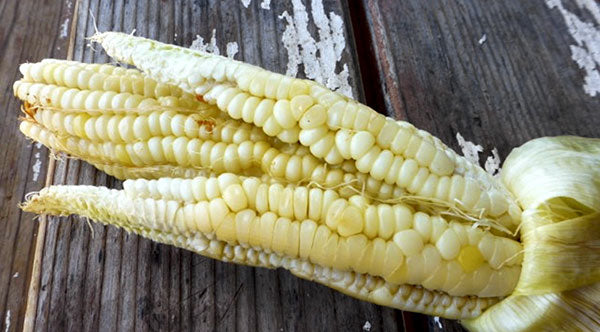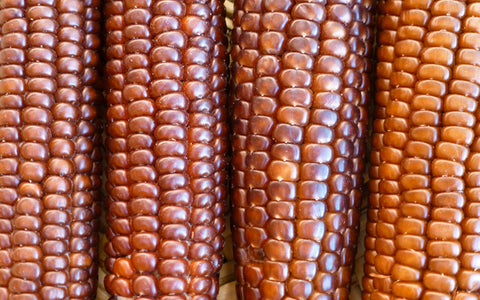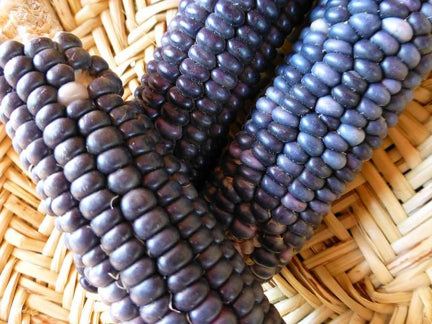
By Laura Neff, Education Associate.
Many people know that maize, known more commonly as corn, is one of the most culturally important crops in the Southwestern U.S. and Mexico, but the true diversity of corn as well as its many culinary uses are unknown to many. At Native Seeds/SEARCH we steward 1,900 different accessions of seed, which includes over 500 different accessions of corn, making Zea mays the most represented species in our seed bank collection. Different types of corn - such as sweet, dent, and flour - are defined by their internal kernel structure and the proportions of soft and hard endosperm, or starch, present. These proportions of starches allow different types of corn to have different culinary properties. In this blog, our goal is for you to learn about the structural differences of the kernel in each type of corn as well as the food that each type has inspired.
Popcorn
Popcorn is one of the oldest types of domesticated corn. The characteristics of the popcorn kernels are very similar to those in flint corn (described below). The popcorn kernel has a hard yet brittle, slightly translucent kernel that is glass-like. When popcorn is heated, the moisture inside the kernel turns to steam that builds up enough pressure for the kernel to explode- creating the white, starchy, edible mass that we all know and love. All popcorn pops a white color due to the color of the endosperm (starch), but if it is a colored popcorn kernel and you look close enough, you may see a little bit of the color in the middle of the exploded kernel. That is the pericarp or outer hull where the kernel color comes from. Recommended varieties: Flor del Rio and Chapalote (for southern latitudes; pictured)

Culinary Uses: While the culinary uses extend beyond enjoying popcorn at the movies, this variety is not recommended as a type to eat fresh. Popcorn is typically used as a dried product and then ground, toasted or popped to make delicious foods. Popcorns can also be nixtamalized (a preparation process in which the corn is soaked and cooked in water and an alkaline solution such as cal, calcium hydroxide, or pickling lime in some groceries, washed, and then hulled to remove the outer shell and soften the kernel). Foods prepared from nixtamalization include hominy used to make masa for tamales and tortillas. Other dried kernel preparations include grinding into a coarse cornmeal for grits, polenta (a sweetened and spiced roasted ground maize resulting powder is then used as an ingredient to make different foods, such as cereals, baked goods, tortillas, and beverages), and atole (a drink that typically includes masa, water, piloncillo or unrefined cane sugar, cinnamon, vanilla and optional chocolate or fruit).
Flint
Flint corn is known for its hard outer layer which protects the small, soft endosperm inside the kernel. This hard outer layer is said to be “as hard as flint” hence the name. They have a glassy appearance. It can also be “popped” when heated, but often the kernels will crack open rather than explode. The hardness of the kernel allows these varieties to store very well and be less susceptible to insect and rodent predation. Flint corns come in a large range of colors. Recommended varieties: Onaveño (pictured) and Southern Maíz Blanco

Culinary Uses: Because of its hard outer layer and lack of sugar, the recommended primary uses of flint corn are as a coarse cornmeal used for grits, polenta, and atole, as well as toasted and ground for pinole. You can nixtamalize flint corn to be used as hominy to make masa tortillas, or posole (a light pork or chicken stew, made starchy with the addition of hominy). Keep in mind that corn referred to as “flint” will often have a starchy, gummy texture.
Flour
The most commonly planted type of corn in the Southwest is flour corn. Flour corn is composed mainly of soft starch, which gives it the ability to be easily ground into a finer cornmeal than any other type would be able to provide. Flour corn can be eaten in its immature or “milk” stage when steamed or BBQ’d. While it is sweeter and more tender than flint types in this stage, it is not as sweet as sweet corn types. Most often flour corn is harvested when fully ripe and dry and ground into cornmeal.
The flavor of a flour corn is subtle and delicate. Without the dense oils and proteins packed into the endosperm, the flavor is not as rich as other varieties. However, its soft texture makes it much easier to grind and digest.
Flour corn varieties come in all colors. The color is contained within the thin outer layer while the interior soft starch is white. Therefore, most ground cornmeal will have a white-gray color in appearance regardless of kernel color. Color in the final baked product using the cornmeal, such as bread or tortillas, can be intensified by adding an alkaline material such as wood ash or completing the nixtamalization process. Recommended varieties: Tohono O’odham 60-Day and Hopi Blue (pictured)

Culinary uses: Flour corn is best known for the fine-grained cornmeal it yields when ground, but did you know that whole kernels can be used as well? Whole kernels are used for posole, chicos (roasted green corn that is then dried), and parched corn (dried and roasted whole corn kernels).
Flour/Flint
Many landrace varieties of corn, like those in the Native Seeds/SEARCH collection do not always fit into nice, neat categories. Because of the nature of open-pollination, many varieties have a mix of kernel texture characteristics. Most commonly within our collection are varieties that are a mix of flour and flint characteristics. When processed, the flinty texture can add body to finer cornmeal made from flour texture types.
A notable example is Pima 60-Day corn. It has about 80% soft flour kernels and 20% hard flint kernels. This balance gives the corn the perfect texture for Ga'ivsa, a wonderfully tasty Pima corn dish. Fresh corn is roasted on the cob over mesquite coals, which gives it a sweet flavor.

Dent
Also known as “field corn”, dent corn makes up the majority of commercially raised corn in the United States. It is primarily used for animal feed, processed foods, and ethanol.
Dent corn was given its name because of the kernel’s appearance as it dries. The kernels contain a hard form of starch at the sides and a soft type in the center. These center starches tend to shrink as the kernel dries, creating a “dent” in the top of the kernel. Dent ears are large and hefty and therefore have tall, strong stalks to support their weight. Typically, the plants do not bush out with numerous stalks- a common trait in flour and flint types. Recommended varieties: Mayo Tuxpeño (pictured) and Día de San Juan

Culinary Uses: Because of its higher starch content, dent corn can be used for fine cornmeal as well as elotes (corn on the cob with condiments such as salt, chile powder, butter, cotija, lemon juice or lime juice, and mayonnaise) when harvested in the green or milk stage. It can be dried to make hominy to grind into masa, or fermented into corn beer.
Sweet
The type we know so well! It can be eaten right off the cob in its early or “milk” stage when it is still tender and juicy, identified by the release of a milky substance from the kernel when pressed. Standard sweet corn originated from genetic mutations which prevent the conversion of sugars into starch. Fascinating...
Sweet corn kernels wrinkle when they are dry as the sugars dehydrate when mature. Varieties come in a diversity of colors. However, the color of the kernels will intensify as the corn ripens past the milk stage. Therefore, when the kernels are still milky and soft, the color is just starting to show. If picked to eat as corn on the cob the kernels will mostly be white to yellow, or bi-color. Recommended varieties: Guarijio Red (for southern latitudes; pictured) and Cocopah (available only to NS/S members and participants in our Native American Seed Request Program).

(left: milk stage; right: mature stage, ready to harvest for seed)
Culinary Uses: Sweet corn is the ideal corn to be eaten fresh in its green or milk stage, but it can also be roasted, dried, and reconstituted (as with chicos). You can even go as far as to grind dried sweet corn into a fine cornmeal for a deliciously sweet pinole .
Pod Corn
This is a variety of corn where each individual kernel is enclosed in long, membranous husks known as glumes. The kernels are naked, or exposed, in other corn. This variant has a mutation of a leaf gene in the maize cob that is not usually active in this portion of the plant. Thus, pod corn is a corn ear that forms leaves in the “wrong” place. It was once thought that pod corn was a wild ancestor of maize, but recent genetic research had shown pod corn ears are the result of this genetic mutation. Because it’s difficult to uncover each individual kernels it is not commonly eaten but is another example of the amazing diversity present in corn.


